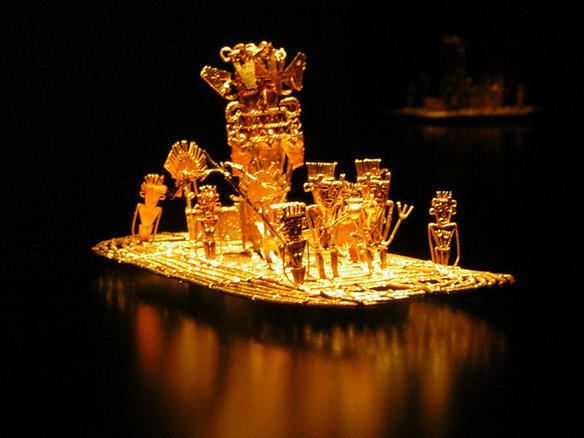This article describes the Muisca mythology; the mythology of the Muisca. Mythology is different from religion in the sense that myths are usually the combination of real events and/or people with a legendary twist, while religion is purely transcedental. The religion of the Muisca is described in Muisca religion; their deities, rituals and sacred sites.
Main contributors to the knowledge of the mythology of the Muisca have been Muisca scholars Javier Ocampo López, Pedro Simón, Lucas Fernández de Piedrahita, Juan de Castellanos and conquistador Gonzalo Jiménez de Quesada who was the European making first contact with the Muisca in the 1530s.
The times before the Spanish conquest of the Muisca Confederation are filled with mythology. The first confirmed human rulers of the two capitals Hunza and Bacatá are said to have descended from mythical creatures. Apart from that other Muisca myths exist, such as the legendary El Dorado and the Monster of Lake Tota.
Several mythological creatures have been described by the chroniclers:
Thomagata, said to have been one of the most religious of the zaques, after IdacansásIdacansás, allegedly a mythical priest from Sugamuxi who was able to change the order of thingsGoranchacha, a mythical cacique who moved the capital of the northern Muisca from Ramiriquí to the later capital HunzaPacanchique, according to Muisca myths recovered his fiancé Azay from ruler Quemuenchatocha by first turning her into a dead person and then bringing her back to life using different plants. He also showed the Spanish conquistadores the way to Nemequene's palaceOther Muisca people where human and mythological character converge are:
Hunzahúa, first zaque of Hunza, allegedly committing incest with his sister and said to have fledMeicuchuca, first zipa of Bacatá, one of his wives mythologically turned into a snakeEl Dorado, the man or city made of gold, that was not so mythical but a main motive for the Spanish to conquer Colombia. The ritual is represented in the Muisca raft, a piece of gold working found in Pasca almost 400 years after the arrival of the SpanishMonster of Lake Tota, allegedly a monstrous snake or fish living in Lake TotaHunzahúa Well, a well that according to the mythology of the Muisca originated from spilled chicha when the mother of Hunzahúa caught him and his sister Noncetá while they were committing incest
